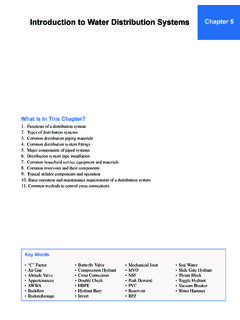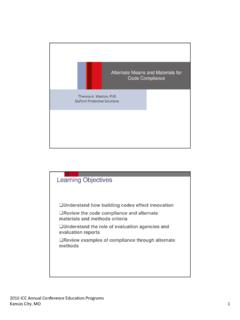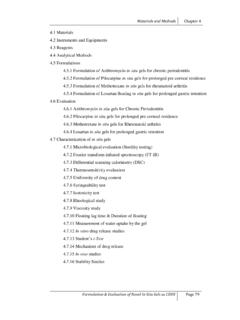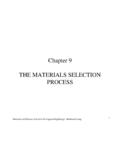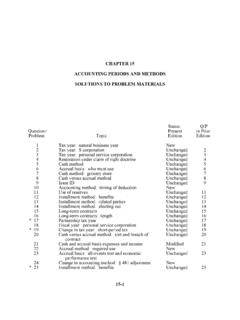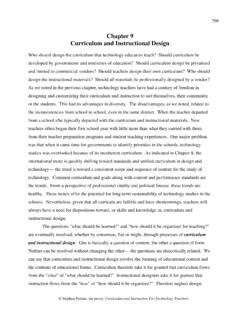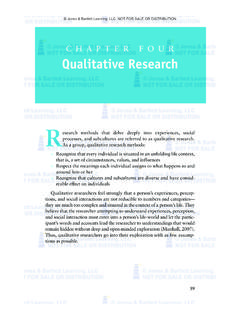Transcription of Chapter 3 Research Method - PBworks
1 Chapter 3 Research MethodEDHE6530Dr. Pu-Shih Daniel ChenOverview Review our progress Chapter 3 Research methods Break How to review journal articles? A quick review of quantitative Research methodsA Quick ReviewChapter One Introduction/problem statement Purpose of the study Conceptual framework or theoretical orientation Research questions and hypotheses Definition of terms Significance of the study Limitations, delimitations, & assumptionsKey to a good literature review Always keep your Research questions in mind Critically analyze the literature Integrate instead of summarize Use primary sources Distinguish between assertion and evidenceOther tips Don t ignore studies that differ from majority or personal bias Read most recent ones first, oldest last Read important landmark works Use data-based.
2 Empirical studies Opinion pieces and descriptive Research helpful in introduction set stage Not a literary production- be clear and conciseBasic Research Theory Driven Discovery of knowledgeApplied Research IMMEDIATE practical problem ACTUAL problems in the field Limited generalizabilityResearch vs. AssessmentResearch Generate knowledge that can be applied broadly Audience is not location-bounded Sample basedAssessment Evaluate the progress or results of a initiative or program Internally focused To improve the project or process Population basedQuantitative vs. Qualitative Epistemology Treatment of Theory Role of the researcher(s) Data collection and analysis Quality controls Report of findings Types of studies How to choose between the two methodsQuantitative methods Experimental Design Casual-Comparative Design Survey Research Secondary Data Research Descriptive DesignQualitative methods Ethnography Case Study Grounded Theory Narrative Inquiry Content AnalysisIdeological Approaches Researcher s role Interpreting the phenomenon through a particular perspective Identifying marginalized or endangered people in society To advocate Challenging traditional views and usually controversial Mixed- Method Philosophically torn between positivist and Phenomenology Pragmatism comes to save the day Focusing on solving the problems instead of
3 Philosophical arguments Mixed- Method is NOThalf quantitative and half qualitativeDiscuss Your Research Questions and Possible Method SelectionsChapter 3 Research MethodsPurpose of the Method Chapter Make your Research transparent Make it possible to other researchers to replicate your study Make it possible for other researchers to judge the quality of your studyDid you remember?Always keep your Research questions in mindFour questions are addressed Who participated in the study? Types of materials needed? What data were collected and how? How did you analyze the data?Participants/Sample How were they selected? Random selection Volunteers Paid From where are participants Geographic region Institutional affiliationParticipants/Sample Demographic characteristics Age/age range Gender Ethnicity Other information for replicationExample of ParticipantsA total of 50 participants will be selected from a population of 157 students enrolled in an Algebra I course at a large urban high school in Houston, TX.
4 The population is tricultural, composed primarily of Caucasian non-Hispanic, African American, and Hispanic students from a variety of Latin American backgrounds. Moreover, 100% of students at this school are enrolled in the free or reduced price lunch program. Participants, comprisedExample of Participantsof 54% female and 46% male, will be selected randomly through use of random numbers table (Ary, Jacobs, & Razavieh, 1996).Instrumentation Describes things used Sources of data Test, questionnaire, Archival sources Why instruments selected Quality of your instrument Validity ReliabilityInstrumentation Who and how administered? How many items How long to complete How scored Special condition If new instrument developed Why Field test?
5 Include in entirety as table or appendixExample of InstrumentationThe Stanford Achievement Test (SAT): Arithmetic Test (Level ) will be utilized as the data gathering instrument. Split-half reliability coefficients are reported to range from .86 to .93 (Davies, 1994) and reviewers (Locus, 1995; Smythe, 1994) are in agreement concerning its high content validity. The SAT Arithmetic test is comprised of 45 multiple-choice items and requires approximately 35 minutes to is missing from the example? Why instruments selected How scored (what is the score range and distribution?)Procedures What did researchers/participants do? When? In what order were activities conducted? If intervention or treatment given, describe in detail Write in cookbook manner; step-by-step process Remember enough details for replicationExample of ProceduresIn the fall of 1997, prior to the assignment of students to classes, a list of all students scheduled to enroll in General Math I in the fall (approximately 150) will be obtained from the principle of the school.
6 Using this list, 50 students will be randomly selected through use of a random numbers table to participate in the study. These 50 students will then be randomly assigned to one of two General Math I classes, one class to receiveExample of Proceduresprogrammed instruction and one class to receive lecture-discussion instruction. The random assignments to class type will also be performed through the use of a random numbers table. The programmed instruction class will utilize a computer program titled Herculette, published by the Programmers Institute of Technology School (1996), and used on IBM or IBM compatible computers with a Pentium 686 processor. In this program,Example of Proceduresstudents are required to exhibit mastery learning on each lesson prior to making a transition to the next higher lesson in the math sequence.
7 The lecture-discussion classroom teacher will present the same math concepts used in the Herculetteprogram but through a lecture format instead of through use of a computer. Discussion will occur between the teacher and students when students ask questions about math Analysis Describe techniques to analyze data Quantitative studies Statistics procedures A brief description and explanation of the statistics you choose to use The reason for choosing this statistical Method Qualitative studies data summary, interpretation, and Method of verification Give as much details as possible Remember triangulation how you going to achieve thatExample of Data AnalysisA statistical analysis will be used for comparing the achievement, on a test of reading comprehension, of two randomly formed groups of second grade students.
8 An independent samples t-test will be used to determine whether the means of these two groups are statistically significantly different from one another. Should the data analysis provide a statistically significant result at the .05 level, then null hypothesis will be of Data AnalysisShould the statistical analysis not yield a statistically significant result at the .05 level, then the null hypothesis will not be rejected. For each comparison, an alpha level of .05 will be used for the level of statistical Activities Outline your Chapter 3 Population/Sample/Participants Instrumentation Data collection methods Data analysisA Quick Review ofQuantitative Research MethodsStatistics methods for Social Sciences Major assumptions in statistics Types of questions that can be answered Are they different?
9 What is the relationship? What cause it to happen? What cause the whole thing to work like that?Population vs. Sample Populationis the entire group of individuals that we want information about Sampleis the part of the population that we actually examine in order to gather informationWhich is which?A study of political orientation of African American female registered voters under age 25 in the 2008 presidential election All female African American undergraduates at UNT who said they are going to voteSampleWhich is which?A study of Latino freshmen at the Collin County Community College in terms of their intention to transfer to four-year institutions A survey of all Latino freshmen at the Collin County Community College with 100% response ratePopulationPopulation ResearchNo Statistics RequiredIs that good or bad?
10 Probability The FoundationKey Elements in Probability Randomness the lack of bias or manipulation Law of large numbers Central limit theorem (CLT)Example for CLT5 5 9 7 Average Adult Male Height in the for CLT5 5 9 7 Average Adult Male Height in the 4 Example for CLT5 5 9 7 Average Adult Male Height in the 6 Example for CLT5 5 9 7 Average Adult Male Height in the 10 Example of CLTS ampleHeightX15 4 Example of CLTS ampleHeightX15 4 X26 6 Example of CLTS ampleHeightX15 4 X26 6 X35 10 Example of CLTS ampleHeightX15 4 X26 6 X35 10 X4, X5,X6,..,Xn5 3 ,6 9 ..Average(X1-Xn)5 9 Example for CLTE xample for CLT5 5 9 7 Average Adult Male Height in the <20% 5 4 What does p < .05 mean? Hypothesis Significance Testing (NHST) Originated from agricultural sciences Test the probability of null hypothesis If the probability for null hypothesis to happen is less than a certain value (p<.)

